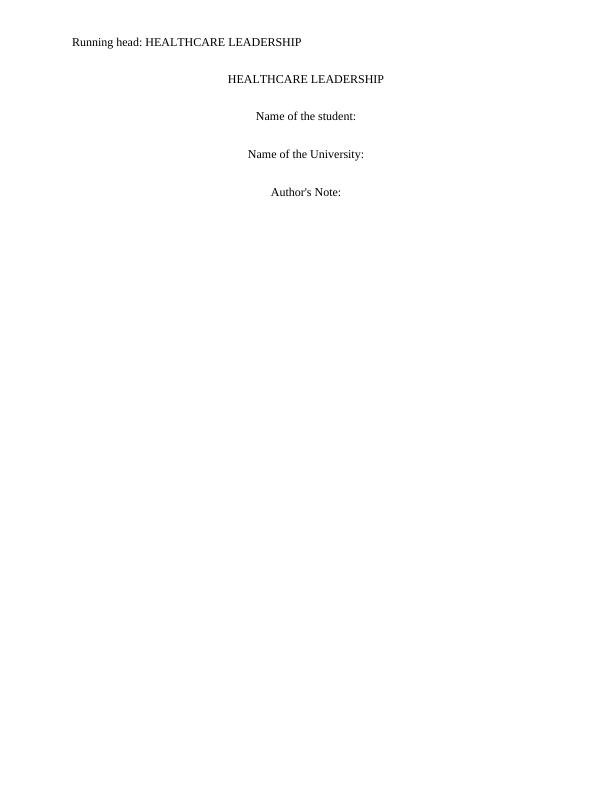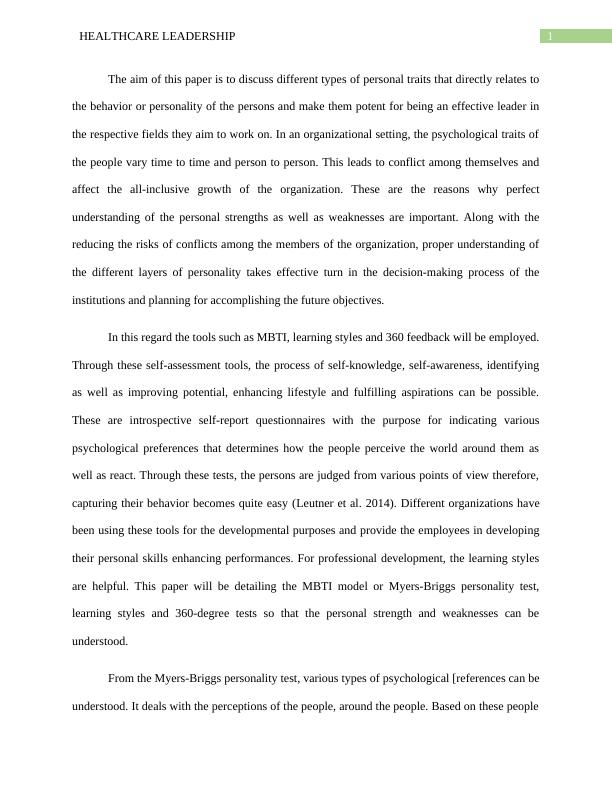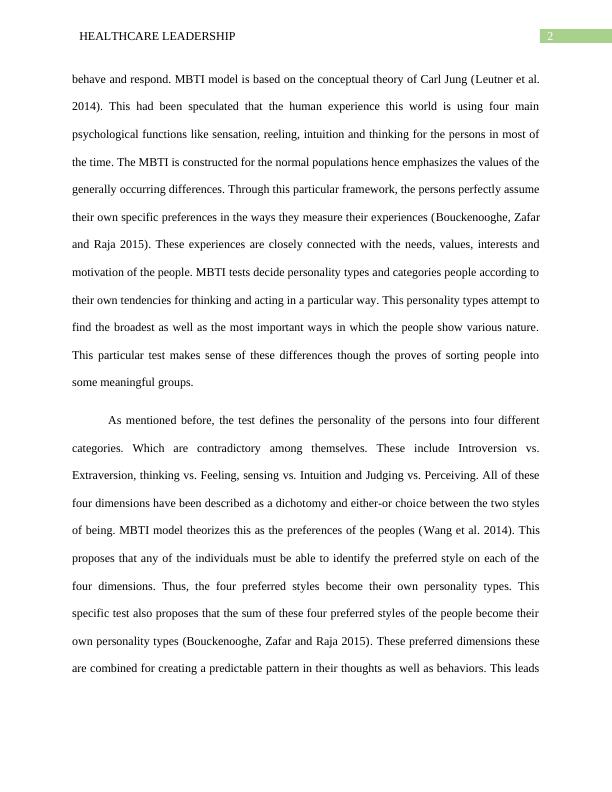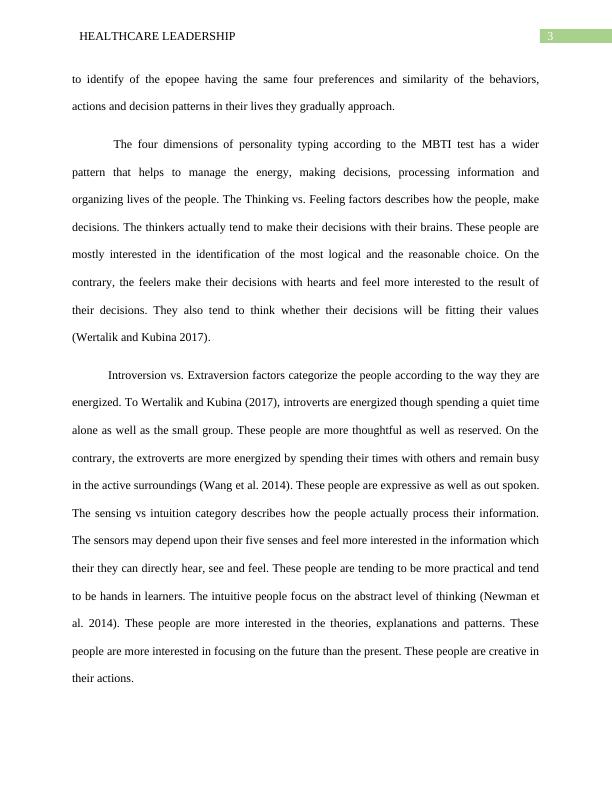Understanding Personal Traits for Effective Healthcare Leadership
Added on 2023-04-20
18 Pages5396 Words321 Views
Running head: HEALTHCARE LEADERSHIP
HEALTHCARE LEADERSHIP
Name of the student:
Name of the University:
Author's Note:
HEALTHCARE LEADERSHIP
Name of the student:
Name of the University:
Author's Note:

1HEALTHCARE LEADERSHIP
The aim of this paper is to discuss different types of personal traits that directly relates to
the behavior or personality of the persons and make them potent for being an effective leader in
the respective fields they aim to work on. In an organizational setting, the psychological traits of
the people vary time to time and person to person. This leads to conflict among themselves and
affect the all-inclusive growth of the organization. These are the reasons why perfect
understanding of the personal strengths as well as weaknesses are important. Along with the
reducing the risks of conflicts among the members of the organization, proper understanding of
the different layers of personality takes effective turn in the decision-making process of the
institutions and planning for accomplishing the future objectives.
In this regard the tools such as MBTI, learning styles and 360 feedback will be employed.
Through these self-assessment tools, the process of self-knowledge, self-awareness, identifying
as well as improving potential, enhancing lifestyle and fulfilling aspirations can be possible.
These are introspective self-report questionnaires with the purpose for indicating various
psychological preferences that determines how the people perceive the world around them as
well as react. Through these tests, the persons are judged from various points of view therefore,
capturing their behavior becomes quite easy (Leutner et al. 2014). Different organizations have
been using these tools for the developmental purposes and provide the employees in developing
their personal skills enhancing performances. For professional development, the learning styles
are helpful. This paper will be detailing the MBTI model or Myers-Briggs personality test,
learning styles and 360-degree tests so that the personal strength and weaknesses can be
understood.
From the Myers-Briggs personality test, various types of psychological [references can be
understood. It deals with the perceptions of the people, around the people. Based on these people
The aim of this paper is to discuss different types of personal traits that directly relates to
the behavior or personality of the persons and make them potent for being an effective leader in
the respective fields they aim to work on. In an organizational setting, the psychological traits of
the people vary time to time and person to person. This leads to conflict among themselves and
affect the all-inclusive growth of the organization. These are the reasons why perfect
understanding of the personal strengths as well as weaknesses are important. Along with the
reducing the risks of conflicts among the members of the organization, proper understanding of
the different layers of personality takes effective turn in the decision-making process of the
institutions and planning for accomplishing the future objectives.
In this regard the tools such as MBTI, learning styles and 360 feedback will be employed.
Through these self-assessment tools, the process of self-knowledge, self-awareness, identifying
as well as improving potential, enhancing lifestyle and fulfilling aspirations can be possible.
These are introspective self-report questionnaires with the purpose for indicating various
psychological preferences that determines how the people perceive the world around them as
well as react. Through these tests, the persons are judged from various points of view therefore,
capturing their behavior becomes quite easy (Leutner et al. 2014). Different organizations have
been using these tools for the developmental purposes and provide the employees in developing
their personal skills enhancing performances. For professional development, the learning styles
are helpful. This paper will be detailing the MBTI model or Myers-Briggs personality test,
learning styles and 360-degree tests so that the personal strength and weaknesses can be
understood.
From the Myers-Briggs personality test, various types of psychological [references can be
understood. It deals with the perceptions of the people, around the people. Based on these people

2HEALTHCARE LEADERSHIP
behave and respond. MBTI model is based on the conceptual theory of Carl Jung (Leutner et al.
2014). This had been speculated that the human experience this world is using four main
psychological functions like sensation, reeling, intuition and thinking for the persons in most of
the time. The MBTI is constructed for the normal populations hence emphasizes the values of the
generally occurring differences. Through this particular framework, the persons perfectly assume
their own specific preferences in the ways they measure their experiences (Bouckenooghe, Zafar
and Raja 2015). These experiences are closely connected with the needs, values, interests and
motivation of the people. MBTI tests decide personality types and categories people according to
their own tendencies for thinking and acting in a particular way. This personality types attempt to
find the broadest as well as the most important ways in which the people show various nature.
This particular test makes sense of these differences though the proves of sorting people into
some meaningful groups.
As mentioned before, the test defines the personality of the persons into four different
categories. Which are contradictory among themselves. These include Introversion vs.
Extraversion, thinking vs. Feeling, sensing vs. Intuition and Judging vs. Perceiving. All of these
four dimensions have been described as a dichotomy and either-or choice between the two styles
of being. MBTI model theorizes this as the preferences of the peoples (Wang et al. 2014). This
proposes that any of the individuals must be able to identify the preferred style on each of the
four dimensions. Thus, the four preferred styles become their own personality types. This
specific test also proposes that the sum of these four preferred styles of the people become their
own personality types (Bouckenooghe, Zafar and Raja 2015). These preferred dimensions these
are combined for creating a predictable pattern in their thoughts as well as behaviors. This leads
behave and respond. MBTI model is based on the conceptual theory of Carl Jung (Leutner et al.
2014). This had been speculated that the human experience this world is using four main
psychological functions like sensation, reeling, intuition and thinking for the persons in most of
the time. The MBTI is constructed for the normal populations hence emphasizes the values of the
generally occurring differences. Through this particular framework, the persons perfectly assume
their own specific preferences in the ways they measure their experiences (Bouckenooghe, Zafar
and Raja 2015). These experiences are closely connected with the needs, values, interests and
motivation of the people. MBTI tests decide personality types and categories people according to
their own tendencies for thinking and acting in a particular way. This personality types attempt to
find the broadest as well as the most important ways in which the people show various nature.
This particular test makes sense of these differences though the proves of sorting people into
some meaningful groups.
As mentioned before, the test defines the personality of the persons into four different
categories. Which are contradictory among themselves. These include Introversion vs.
Extraversion, thinking vs. Feeling, sensing vs. Intuition and Judging vs. Perceiving. All of these
four dimensions have been described as a dichotomy and either-or choice between the two styles
of being. MBTI model theorizes this as the preferences of the peoples (Wang et al. 2014). This
proposes that any of the individuals must be able to identify the preferred style on each of the
four dimensions. Thus, the four preferred styles become their own personality types. This
specific test also proposes that the sum of these four preferred styles of the people become their
own personality types (Bouckenooghe, Zafar and Raja 2015). These preferred dimensions these
are combined for creating a predictable pattern in their thoughts as well as behaviors. This leads

3HEALTHCARE LEADERSHIP
to identify of the epopee having the same four preferences and similarity of the behaviors,
actions and decision patterns in their lives they gradually approach.
The four dimensions of personality typing according to the MBTI test has a wider
pattern that helps to manage the energy, making decisions, processing information and
organizing lives of the people. The Thinking vs. Feeling factors describes how the people, make
decisions. The thinkers actually tend to make their decisions with their brains. These people are
mostly interested in the identification of the most logical and the reasonable choice. On the
contrary, the feelers make their decisions with hearts and feel more interested to the result of
their decisions. They also tend to think whether their decisions will be fitting their values
(Wertalik and Kubina 2017).
Introversion vs. Extraversion factors categorize the people according to the way they are
energized. To Wertalik and Kubina (2017), introverts are energized though spending a quiet time
alone as well as the small group. These people are more thoughtful as well as reserved. On the
contrary, the extroverts are more energized by spending their times with others and remain busy
in the active surroundings (Wang et al. 2014). These people are expressive as well as out spoken.
The sensing vs intuition category describes how the people actually process their information.
The sensors may depend upon their five senses and feel more interested in the information which
their they can directly hear, see and feel. These people are tending to be more practical and tend
to be hands in learners. The intuitive people focus on the abstract level of thinking (Newman et
al. 2014). These people are more interested in the theories, explanations and patterns. These
people are more interested in focusing on the future than the present. These people are creative in
their actions.
to identify of the epopee having the same four preferences and similarity of the behaviors,
actions and decision patterns in their lives they gradually approach.
The four dimensions of personality typing according to the MBTI test has a wider
pattern that helps to manage the energy, making decisions, processing information and
organizing lives of the people. The Thinking vs. Feeling factors describes how the people, make
decisions. The thinkers actually tend to make their decisions with their brains. These people are
mostly interested in the identification of the most logical and the reasonable choice. On the
contrary, the feelers make their decisions with hearts and feel more interested to the result of
their decisions. They also tend to think whether their decisions will be fitting their values
(Wertalik and Kubina 2017).
Introversion vs. Extraversion factors categorize the people according to the way they are
energized. To Wertalik and Kubina (2017), introverts are energized though spending a quiet time
alone as well as the small group. These people are more thoughtful as well as reserved. On the
contrary, the extroverts are more energized by spending their times with others and remain busy
in the active surroundings (Wang et al. 2014). These people are expressive as well as out spoken.
The sensing vs intuition category describes how the people actually process their information.
The sensors may depend upon their five senses and feel more interested in the information which
their they can directly hear, see and feel. These people are tending to be more practical and tend
to be hands in learners. The intuitive people focus on the abstract level of thinking (Newman et
al. 2014). These people are more interested in the theories, explanations and patterns. These
people are more interested in focusing on the future than the present. These people are creative in
their actions.

End of preview
Want to access all the pages? Upload your documents or become a member.
Related Documents
Judging and Conscientiousness were true measures of personalitylg...
|3
|613
|81
Managing Conflicts Through Self-Awarenesslg...
|8
|2072
|220
MAN201 Self-awareness and Professional Life of Leader : Assignmentlg...
|16
|3968
|278
Report on Organisational Behaviourlg...
|19
|3633
|184
Understanding the Myers-Briggs Technique for Psychology and Workplacelg...
|12
|2659
|276
Self-Assessment for Leadership Skill Buildinglg...
|10
|2636
|24
